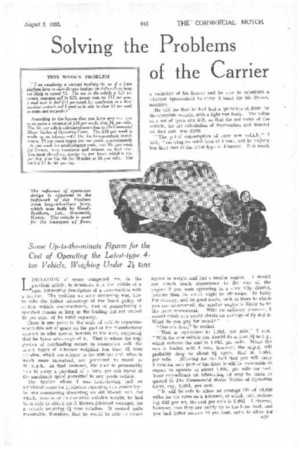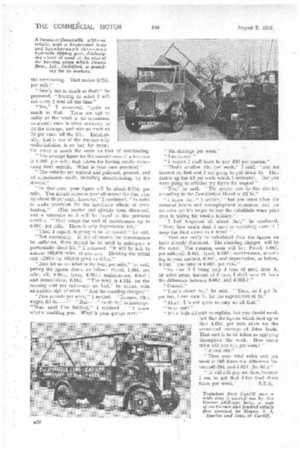Solving the Problems of the Carrier
Page 43

Page 44

If you've noticed an error in this article please click here to report it so we can fix it.
LIMITATION of space compelled me, in the previous article, to terminate it in the middle of a most interesting description of a conversation with a haulier. The problem we were discussing was, how to take the fullest advantage of the latest policy of certain vehicle manufacturers, that of guaranteeing a specified chassis so long as the loading did not exceed 25 per cent. of its rated capacity.
There is one point in the scale of vehicle capacities where this act of grace on the part of the manufacturer appears to offer special benefits to the user, supposing that he takes advantage of it. That is where the suggestion of overloading occurs in connection with the newer types of 4-tormer weighing less than 2i tons unladen, which are subject to the £30 tax and, what is much more important, are permitted to travel at 30 m.p.h. In that instance, the user is presumably able to carry a pay-load of 5 tons, yet can travel at the maximum speed permitted to any goods vehicle.
The haulier whom 1 was interviewing had an additional cause for jubilation regarding this possibility : he was considering discarding an old 30-cwt. van, for which, because of its excessive unladen weight, he had been able to obtain an A licence, (claimed tonnage), for a vehicle weighing 2-i tons unladen. It seemed quite reasonable, therefore, that he would be able to obtain lighter in weight and has a smaller engine. I should not attach much importance to the size of the engine if you were operating in a very hilly district, because then the result might be otherwise. In fairly flat country, and on good roads, such as those to which you are accustomed, the smaller engine is likely to be the more economical. With an ordinary 4-tonner, I should think you would obtain an average of 81 m.p.g. What do you pay for petrol? "
"One-and-four," he replied.
"That is equivalent to 1.88d, per mile," I said. " With the new vehicle you should do at least 9-i m.p.g., which reduces the cost to 1.68d. per mile. While the van is loaded with 6 tons, however, the m.p.g. will probably drop to about 8i again, that is, 1.88d.
per mile. Allowing for the fact that you will carry 5 tons for only part of the time, it will be reasonable to expect to operate at about 1.80d. per mile for fuel. Your expenditure on lubricating oil may be taken as quoted in The Commercial Motor Tables of Operating Costs, say, 0.08d. per mile.
"It will be sale to allow an average life of 16,000 miles for the tyres on a 4-tonner, at which rate, reckoning £45 per set, the cost per mile is 0.68d. I observe, however, that they are barely up to the 5-ton load, and you had better assume 10 per cent, extra to allow for the overloading. That makes 0.75d. per mile."
"Surely not so much as that?" he protested, "bearing in mind I will not carry 5 tons all the time."
"Yes," I answered, "quite as much as that. Tyres are apt to suffer as the result of an occasional overload; once is often sufficient to do the damage, and take as much as 50 per cent. off the life. Incident ally, that is one of the reasons why under-inflation is so bad for tyres; the effect is much the same as that of overloading.
"The average figure for the maintenance of a 4-tonner is 1.10d. per mile; that allows for having nearly everything done outside. What is your own practice? "
"The vehicles are washed and polished, greased, and all adjustments made, including decarbonizing, by the drivers."
"In that case, your figure will be about 0.70d. per mile. You should increase your allowance for that item by about 20 per cent., however," I continued, "in order to make provision for the inevitable effects of over loading." (This matter had already been discussed, and a reference to it will be found in the previous article.) "That brings the cost of maintenance up to 0.85d. per mile. There is only depreciation left."
"That, I expect, is going to be increased? " he said.
"Not necessarily. If the allowance for maintenance be sufficient, there should be no need to anticipate a particularly short life," I returned; "it will be safe to assume 160,000 miles, at any rate. Dividing the initial cost (R360) by 160,000 gives us 0.54d."
"Now let us see what is the total per mile," he said, jotting the figures down, as follow : Petrol, 1.80d. per mile; oil, 0.08d.; tyres, 0.75d.; maintenance, 0.85d.; and depreciation, 0.54d. "The total is 4.02d, for the running cost per mile—not too bad," he added, with an audible sigh of relief. "And the standing charges? "
"Five pounds per week," I replied. "Licence, 12s.; wages, £3 5s.---" "But—" he started to interrupt. " Wait until I've finished," I rejoined. . "I know what's troubling you. What is your garage rent?" "Six shillings per week."
"Insurance? "
"I expect I shall have to pay £30 per annum."
"That's another 12s. per week," I .said, "and for interest on first cost I am going to put down 5s. That makes up the £5 per week which I estimated. But you
were going to criticize my figure for wages?"
"Yes," he said. "The Proper rate in this district,
according to the Conciliation Board is £3-1s."
"I know that," I replied, "but you must allow for national health and unemployment insurance, and for an extra week's wages to pay the substitute when your man is taking his week's holiday."
" I had forgotten all about that," he confessed. " Now, how much shall I save in operating costs if I keep the load down to 4 tons? "
"That can easily be calculated from the figures we have already discussed. The standing charges will be the same. The running costs will be : Petrol, 1.68d. per mile; oil, 0.08d.; tyres, 0.68d.; maintenance, accord ing to your method, 0.70d., and depreciation, as before, 0.54d. The total is 3.68d. per mile."
" So that if I bring only 4 tons of meal from A, 35 miles away, instead of 5 tons, I shall save 35 times the difference between 3.68d. and 4.02d.? "
"Correct."
"That's about Is.," he said. "Then, as I get 7s, per ton, I can earn 7s. for the expenditure of Is." " Aha I It's not quite so easy as all that."
"Why not?" "It's a little difficult to explain, but you should recollect that the figures which lead up to that 4.02d. per mile allow for the occasional carriage of 5-ton roads. That cost is to be taken as applying throughout the week. How many miles will you run per week?" "About 300."
"Then your total extra cost per week is 300 times the difference bbtween,a3.68d. and 4.02d. (8s. 6d.)."
" It will still pay me then, because I am to get that 5-ton load three times per week."












































































